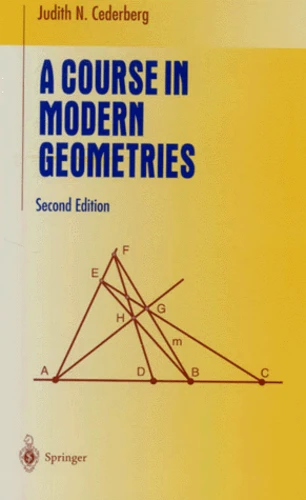A Course in Modern Geometries.. 2nd Edition
Par :Formats :
- Réservation en ligne avec paiement en magasin :
- Indisponible pour réserver et payer en magasin
- Nombre de pages439
- PrésentationRelié
- Poids0.79 kg
- Dimensions16,0 cm × 24,5 cm × 2,5 cm
- ISBN0-387-98972-2
- EAN9780387989723
- Date de parution03/01/2001
- CollectionUndergraduate texts in maths
- ÉditeurSpringer
Résumé
A Course in Modern Geometries, Second Edition, is designed for a junior-to senior-level course for mathematics majors, including those who plan to teach in secondary school. Chapter 1 presents several finite geometries in an axiomatic framework. Chapter 2 continues the synthetic approach as it introduces Euclid's geometry and ideas of non-Euclidean geometry. In Chapter 3, a new introduction to symmetry and hands-on explorations of isometries precede the extensive analytic treatment of isometries, similarities, and affinities. A new concluding section explores isometries of space. Chapter 4 presents plane projective geometry both synthetically and analytically. The extensive use of matrix representations of groups of transformations in Chapters 3 and 4 reinforces ideas from linear algebra and serves as on excellent preparation for a course in abstract algebra. The new Chapter 5 uses a descriptive and exploratory approach to introduce chaos theory and fractal geometry, stressing the self-similarity of fractals and their generation by transformations from Chapter 3. Each chapter includes a list of suggested resources for applications or related topics in areas such as art and history. This second edition also includes pointers to the web location of author-developed guides for dynamic software explorations of the Poincaré model, isometries, projectivities, conics, and fractals. Parallel versions of these explorations are available for Cabri Geometry and Geometer's Sketchpad.
A Course in Modern Geometries, Second Edition, is designed for a junior-to senior-level course for mathematics majors, including those who plan to teach in secondary school. Chapter 1 presents several finite geometries in an axiomatic framework. Chapter 2 continues the synthetic approach as it introduces Euclid's geometry and ideas of non-Euclidean geometry. In Chapter 3, a new introduction to symmetry and hands-on explorations of isometries precede the extensive analytic treatment of isometries, similarities, and affinities. A new concluding section explores isometries of space. Chapter 4 presents plane projective geometry both synthetically and analytically. The extensive use of matrix representations of groups of transformations in Chapters 3 and 4 reinforces ideas from linear algebra and serves as on excellent preparation for a course in abstract algebra. The new Chapter 5 uses a descriptive and exploratory approach to introduce chaos theory and fractal geometry, stressing the self-similarity of fractals and their generation by transformations from Chapter 3. Each chapter includes a list of suggested resources for applications or related topics in areas such as art and history. This second edition also includes pointers to the web location of author-developed guides for dynamic software explorations of the Poincaré model, isometries, projectivities, conics, and fractals. Parallel versions of these explorations are available for Cabri Geometry and Geometer's Sketchpad.

